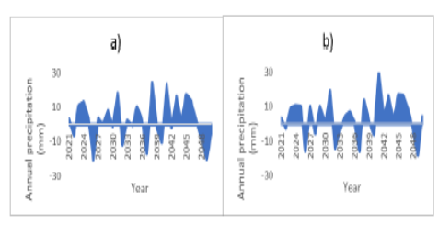


Indian Journal of Science and Technology
Year: 2022, Volume: 15, Issue: 30, Pages: 1466-1472
Original Article
Shilpa A Veerabhadrannavar1, B Venkatesh2
1National Institute of Hydrology, Hard Rock Regional Centre, Visvesvaraya Nagar, Belagavi, Karnataka, 590019, India
2National Institute of Hydrology, Hard Rock Regional Centre, Visvesvaraya Nagar, Belagavi, Karnataka, 590019, India
*Corresponding author
Email: [email protected]
Received Date:15 April 2022, Accepted Date:02 July 2022, Published Date:06 August 2022
Objectives: The current research assessed the patterns of precipitation and discharge in the Sagar and Kokkarne catchments in the Western Ghats of Karnataka. Methods: Soil and Water Assessment Tool (SWAT) model was used to find the discharge at the outlets of the catchments. The yearly precipitation and discharge patterns of both the catchments were studied using data from observed data (1991 to 2020) and the projected data (2021-2050). Considering the IMD data (1991-2020) as the reference data, the percentage change in precipitation and discharge were calculated. Findings: For the Sagar catchment, the maximum percentage change in precipitation and discharge were projected to be 24.79 % and 53.71 %, and the minimum percentage change in precipitation and discharge were projected to be -20.29 % and -41.65 %. For the Kokkarne catchment, the maximum percentage change in precipitation and discharge were projected to be 31.30 % and 42.92 %, and the minimum percentage change in precipitation and discharge were projected to be -18.22 % and -16.98 %. In both the catchments, the increase or decrease in precipitation has led to corresponding changes in the discharge of the catchment. Novelty: This present work tries to project and compare the precipitation and discharge patterns in two catchments belonging to two varied river flow regimes in the Western Ghats of Karnataka to establish how the changing climate is affecting the hydrology of the catchments. As the precipitation varies in intensity throughout time and space and Indian agriculture relies heavily on precipitation, the present study can help in formulating water resource management techniques.
Keywords: Western Ghats; Hydrological Cycle; IPCC; SWAT model; Lockdown; Vaccination
© 2022 Veerabhadrannavar & Venkatesh. This is an open-access article distributed under the terms of the Creative Commons Attribution License, which permits unrestricted use, distribution, and reproduction in any medium, provided the original author and source are credited.
Published By Indian Society for Education and Environment (iSee)
Subscribe now for latest articles and news.